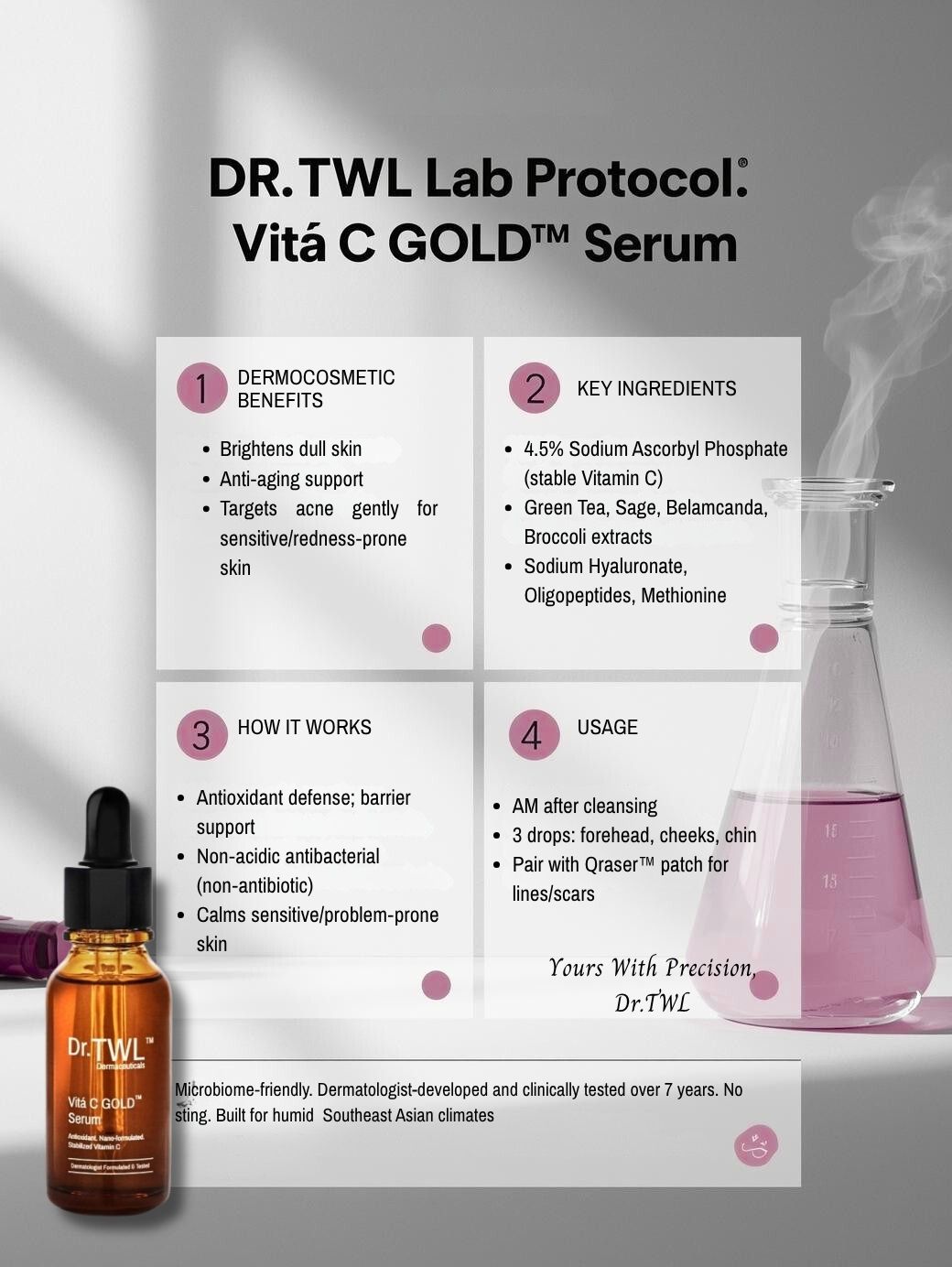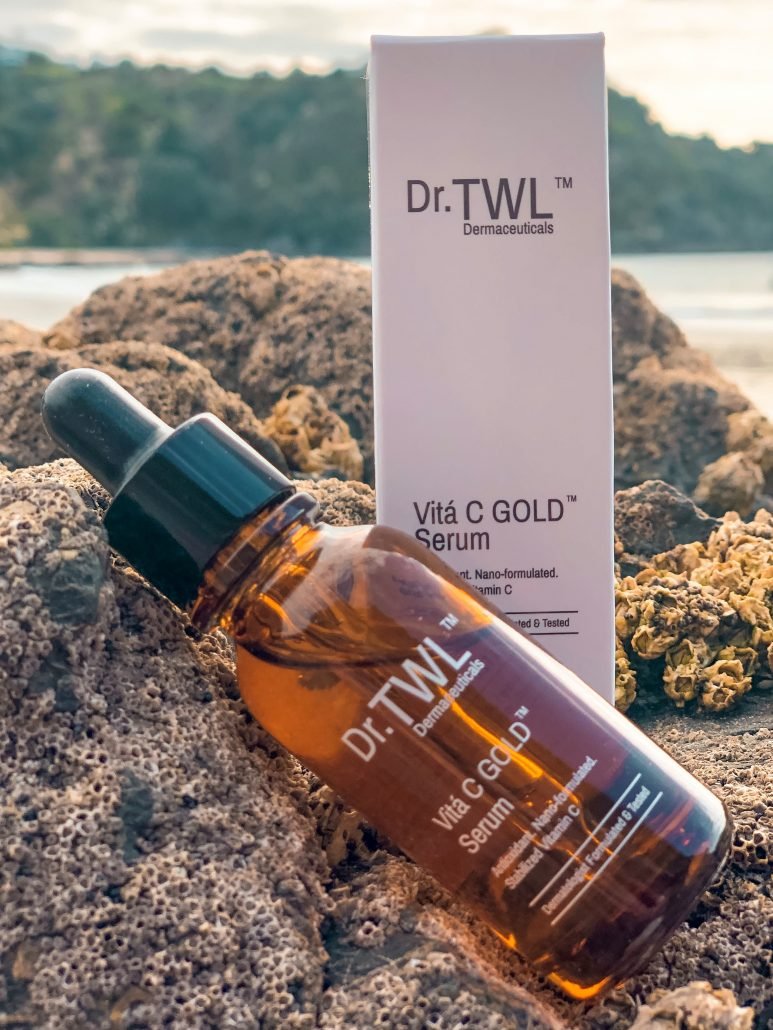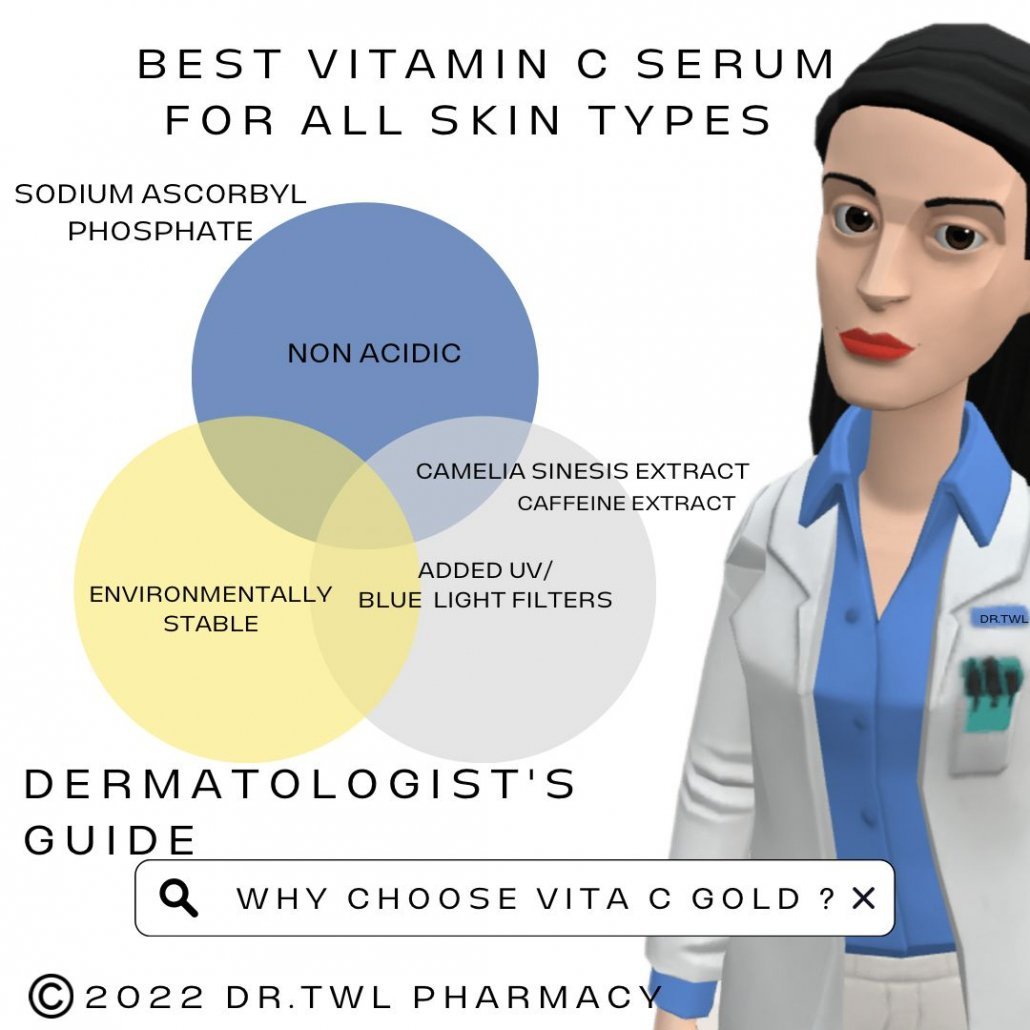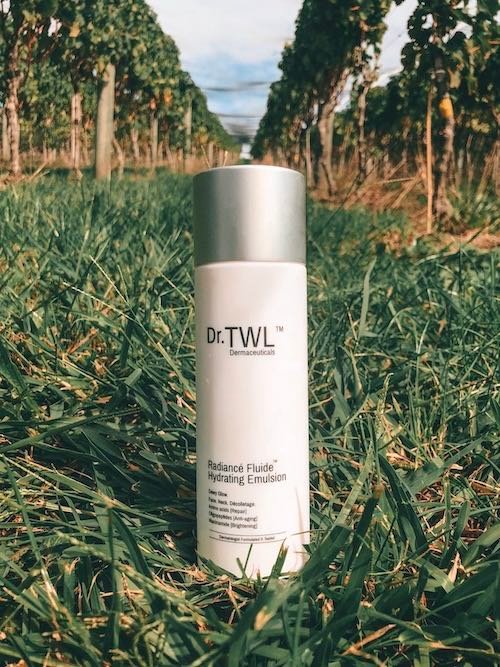Vitamin C for Skin: Is L-Ascorbic Acid the Gold Standard?

Looking for a clear, dermatologist-formulated protocol for daily vitamin C use? The Dr.TWL Lab Protocol above distills the essentials, presenting a stepwise guide for results-driven skincare. If you’re ready to dive deeper beyond the basics—discovering how vitamin C works, why ingredient selection matters, and what sets non-acidic forms apart—this article offers an evidence-based journey guided by our dermatologist founder Dr. Teo Wan Lin. Read on for a comprehensive breakdown of the science, myths, and best practices behind vitamin C in modern dermatology, featured in our podcast episode and blog deep-dive here.

In this podcast episode – ALL ABOUT SERUMS on Dermatologist Talks: Science of Beauty, accredited Singapore dermatologist Dr. Teo Wan Lin explains why her essential serums include Vitamin C and Hyaluronic Acid. Part 1 of this feature goes into the science of different Vitamin C compounds. In addition, we find out if L-Ascorbic Acid is truly the gold standard in anti-ageing and antioxidants. Dr. Teo also covers sensitive skin types and Vitamin C tolerability. Read on and listen to the podcast to learn more!
What is Vitamin C?
L-Ascorbic Acid refers to the chemically active form of Vitamin C or raw Vitamin C. It is an essential nutrient that the human body does not synthesize on its own. Vitamin C also forms a critical part of our diet as an antioxidant. The antioxidant is proven to fight free radical cell damage and facilitate cellular repair in general. Consequently, topical L-ascorbic acid associates with the same antioxidative and cellular repair mechanisms when applied directly to the skin. It in fact delivers targeted efficacy to the human skin instead of solely relying on the dietary route. The dietary route sees a bulk of the vitamins diluted through and excreted from the human body. The antioxidative and healing properties of L-Ascorbic Acid are what constitute the gold standard in anti-ageing which we refer to here.
@drteowanlin #question from @Dr. Teo Wan Lin How does Vita C Gold Work? #vitaminc #skincareserum ♬ original sound – Dr. Teo Wan Lin – Dermatologist Dr.TWL
What is L-Ascorbic Acid best used for?
L-Ascorbic Acid or Vitamin C is required by our bodies to produce collagen, making this vitamin crucial for anti-ageing. Think of it as an anti-ageing shield your skin needs. The shield reduces the damage your skin suffers, and also helps to prevent future damage. The vitamin forms cofactors of enzymes that augment the stability of collagen fibers. It also increases expression of collagen and synthesizes inhibitors to block enzymes from degrading collagen. This thereby contributes to the treatment of wrinkles. Wrinkles are frequently the result of the loss of collagen and skin elasticity with age.
In addition, Vitamin C plays an important role in skin-lightening as it inhibits an enzyme called tyrosinase. Tyrosinase participates in the metabolism of melanin that causes pigmentation on skin. This enzyme works by converting tyrosine into melanin. As a result, by reducing the activity of tyrosinase, our skin cells inadvertently produce less melanin. Furthermore, topical Vitamin C can help improve acne conditions. This is by combating oxidation of sebum and comedogenesis (also commonly referred to as the clogging of pores). All these are by its sheer potent antioxidative strength to neutralise free radicals and reduce oxidative stress. The neutralisation of free radicals also protects the individual from UV light exposure. UV light may lead to photodamage such as via sunburn cell formation and DNA fragmentation.
What are the pros and cons of L-Ascorbic Acid?
L-Ascorbic Acid or raw Vitamin C, whilst fundamentally important as an antioxidant and driver of cellular repair in the human body, may not confer the most benefit when applied topically as it is, in its raw form, to the skin. Chemically, L-Ascorbic acid is highly unstable in solution under atmospheric conditions. Being the potent antioxidant that it is, this inadvertently causes the molecule to react almost instantly with oxygen in the air and be degraded of its functional form. This often results in L-Ascorbic Acid based Vitamin C serums having to be formulated with higher concentrations.
For instance, 20% L-Ascorbic Acid formulations may quite frequently be marketed. This is in order to survive the degradation in some manner. The high concentration is needed for the formulation to have any reasonable efficacy by the time the molecule is absorbed by the epidermis and dermis. A consequence of high concentrations of L-Ascorbic Acid however is that, as may be suggested by its chemical nomenclature, it increases acidity on the skin. For individuals with sensitive or eczema-prone skin, it is not uncommon to experience irritation and flare ups following the use of such highly concentrated L-Ascorbic Acid formulations.
Which vitamin C derivatives would you recommend, and why? Are there any derivatives that you particularly like?
In my practice, I use Sodium Ascorbyl Phosphate (SAP), a stable precursor of L-Ascorbic Acid. We use it in the formulation of a stabilized Vitamin C serum – the Vita C GOLD Serum, which is a cosmeceutical often opted for by patients as adjunctive treatment to acne and pigmentation conditions. The SAP is a salt of ascorbic acid and is stable in solution under atmospheric conditions. This allows the molecule to be kept intact mostly on exposure to environmental oxygen up till absorption through the epidermis and dermis. In skin, the enzyme phosphatase is abundant to cleave off the phosphate group attached to the Ascorbic Acid molecule.

From here, the SAP is converted back to its functionally active L-Ascorbic form. As result, we deliver the efficacy of the vitamin optimally right into the skin without the same losses that may be experienced by conventional Vitamin C serums, due to intermediary exposure to environmental oxygen. What this means is that a much lower 5 percent concentration of SAP (which is the amount present in the Vita C GOLD) for example, could have sufficient potency for similar if not stronger efficacy than more concentrated raw L-Ascorbic formulations. All this whilst avoiding the pitfalls of potential irritation from high concentrations.
In fact, studies have shown that a mere 1 percent concentration of SAP has strong antimicrobial efficacy against acne. Also, one additional benefit of the SAP is that we understand skin cells to continuously take up the SAP and convert it into ascorbic acid by the process of dephosphorylation. This continuous process allows elevated levels of ascorbic acid to be maintained in the skin for considerable lengths of time after the initial introduction of SAP. As a result, we deliver more sustained benefits to the skin.

Which derivative is best suited for sensitive and sensitised skin, as well as those who are new to using actives?
I would recommend the use of stabilized Vitamin C, dermatologist-tested and formulated at concentrations no more than 5% to avoid potential irritation to sensitive skin individuals.
In your opinion, who should use vitamin C in their skincare routine, and who should avoid it? How should we incorporate vitamin C into our routines, for maximum efficacy and safety?
In general, Vitamin C, being a powerful antioxidant and essential nutrient that helps drive cellular repair and wound healing in the human body, is suitable in any skincare routine. This is much like a healthy diet being suitable for anyone. However, for sensitive skin individuals especially, it is important to discern the type and concentration of Vitamin C used in topical formulations. Do also look out for dermatologist-tested and formulated labels for added assurance. Avoid concocting your own Vitamin C, as it may lead to phytophotodermatitis. This is inflammation of the skin from contact with light sensitizing botanicals followed by sunlight exposure. This is somewhat common with patients who DIY using lemon, lime or oranges etc.

On top of the use of stabilized Vitamin C, my patients also often opt for a lightweight moisturising emulsion. The the Radiance Fluide Hydrating Emulation is oil-in-water for a comfortable texture in humid climates. Furthermore, it is imbued with an added mix of antioxidants and plant extracts. These help to augment the anti-aging effects of Vitamin C, via hydration to the skin and a boost to collagen production. Above all, however, I can’t stress enough the importance of a healthy balanced diet (which includes consumption of dietary Vitamin C) and regular exercise to maintain healthy youthful skin.









Leave a Reply
Want to join the discussion?Feel free to contribute!